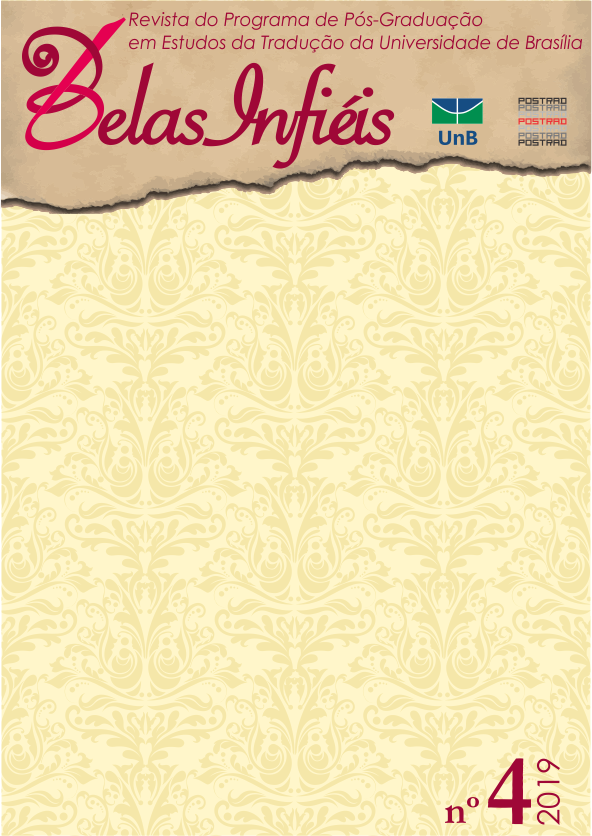Cinema, music and translation: Pedro Almodóvar subtitled in Portugal
DOI:
https://doi.org/10.26512/belasinfieis.v8.n4.2019.24164Keywords:
Cinema. Music. Subtitling. Norms. Almodóvar.Abstract
Since the birth of cinema music has been an important part of movies. In Pedro Almodóvar's work the soundtrack occupies a central place, not only speaking of the characters but also participating in the narratives. The final goal of this research is to confirm the existence of translation tendencies or norms in the specific case of the songs that integrate the films, based on the distinction established by Toury (1985) between preliminary norms and operational norms. We study a corpus composed by the last eight feature films of the Spanish director ”“ from All about my mother (1999), which won the Oscar for the best foreign language film until the last film debuted in Portugal, Julieta (2016). We will see if inter-comprehension and linguistic and territorial proximity can influence the solutions adopted in subtitling. The research allows us to conclude that there is no homogeneity in the translation proposals adopted and, therefore, there is no clear trend to translate the songs since only a third of the songs are subtitled, which will inevitably cause losses in nuances and connotations transmitted through songs. Finally, when we contrast our results with those presented in other investigations about the translation of the director's films into other languages and cultures, we find that there is also no uniformity in the data obtained.
References
ALLINSON, Mark. A Spanish Labyrinth: The Films of Pedro Almodóvar. London & New York: I.B. Tauris, 2001.
AMAGO, Samuel. Todo sobre Barcelona: Refiguring Spanish Identities in Recent European Cinema. HISPANIC RESEARCH JOURNAL 8.1, 2007, p.11-25.
BARTOLL, Eduard. La subtitulació. Aspectes teòrics i prà ctics. Vic: Eumo, 2012.
CARMONA, Ramon. Cómo se comenta un texto fílmico. Madrid: Cátedra, 1996.
CHAUME, Frederic. Cine y traducción. Madrid: Cátedra, 2004.
CHAUME, Frederic. Doblatge i subtitulació per a la TV. Vic: Eumo Editorial, Universitat Pompeu Fabra, Universitat Autònoma de Barcelona, Universitat de Vic, Universitat Jaume I, 2003.
DIAZ FOUCES, Oscar. Algumas considerações sobre a combinação linguística português-espanhol. In: DIAZ FOUCES, Oscar (Ed.), Olhares & Miradas. Granada: Átrio, 2012, p. 119-135.
DÃAZ-CINTAS, Jorge. Teoría y práctica de la subtitulación: inglés/español. Barcelona: Ariel, 2003.
DÃAZ-CINTAS, Jorge; REMAEL, A. Audiovisual Translation: Subtitling. Manchester: St. Jerome, 2007.
IGAREDA, Paula. Lyrics against images: music and audioDescription. In: MonTI 4, p. 233-254, 2012.
IVARSSON, Jan. Subtitling for the Media. A Handbook of an Art. Estocolmo: Transedit, 1992.
IVARSSON, Jan; CARROLL, Mary. Subtitling. Sweden: Simrishamn, 1998.
MORENO, Ana. La traducción de elementos culturales en el texto audiovisual. La obra de Pedro Almodóvar en alemán, francés e inglés. Universidad del País Vasco, Vizcaya, 2005.
OLARTE, Matilde. La música incidental en el cine y el teatro. In: BANÚS, Enrique (Coord.). El legado musical del siglo XX. Pamplona: Ediciones Universidad de Navarra. EUNSA, 2002.
ROUSSOU, Maria. La subtitulación de tres filmes de Almodóvar al griego: Estudio descriptivo. Puentes 6, p. 61-68, 2005.
ROX, María. The films of Pedro Almodóvar: translation and reception in the United States. Tese de doutoramento, Universidad de León, León, Espanha, 2008. Disponível em: https://buleria.unileon.es/bitstream/handle/10612/1417/2008ROX%20BARASOAIN,%20MAR%25CDA.pdf?sequence=1 Acesso em: abr. 2019.
SANDERSON; John D. Imágenes en palabras. La audiodescripción como generadora de estrategias alternativas de traducción. Puntoycoma. Boletín de los Traductores Españoles de las instituciones de la Unión Europea, n. 123. Disponível em: http://ec.europa.eu/translation/bulletins/puntoycoma/123/pyc1238_es.htm. 2011 Acesso em: 7 out. 2019.
SANTAMARÃA CIORDIA, Letícia. Almodóvar po polsku. La imagen de Almodóvar en Polonia y sus consecuencias sobre la traducción de su cine. Lask: Oficyna Wydawnicza LEKSEM. Col. Rozumienie, Interpretacja, Przeklad, 2012.
SØRENSEN, Signe Kok; BANDER, Lea Beliaeva. El subtitulado - no una cosa de coser y cantar Un análisis de los subtítulos daneses de la película Volver de Pedro Almodóvar. Aarhus School of Business, Aarhus University, 2010. Disponível em: http://pure.au.dk/portal/files/11665/EL_SUBTITULADO.pdf Acesso em: abril 2019.
STRAUSS, Frédéric. Pedro Almodóvar: un cine visceral. Madrid: Ediciones El País/Aguilar, 1995.
TOURY, Gideon. Descriptive Translation Studies and Beyond. Amsterdam: John Benjamins, 1995.
REFERÊNCIAS DE FILMES
A PELE onde eu vivo. Produção de: Augustin Almodóvar e Esther García. Realização de: Pedro Almodóvar. DVD. Portugal: Pris audiovisuais, 2012.
ABRAÇOS desfeitos. Produção de: Augustin Almodóvar e Esther García. Realização de: Pedro Almodóvar. DVD. Portugal: Prisvideo S.A., 2009.
FALA com ela. Produção de: Augustin Almodóvar e Michel Ruben. Realização de Pedro Almodóvar. DVD. Portugal: Prisvideo S.A., 2002.
JULIETA. Produção de: Augustin Almodóvar e Esther García. Realização de: Pedro Almodóvar. DVD. Portugal: Pris audiovisuais, 2016.
MÁ educação. Produção de: Augustin Almodóvar e Esther García. Realização de: Pedro Almodóvar. DVD. Portugal: Prisvideo S.A., 2004.
OS AMANTES passageiros. Produção de: Augustin Almodóvar e Esther García. Realização de: Pedro Almodóvar. DVD. Portugal: Pris audiovisuais, 2013.
TUDO SOBRE a minha mãe. Produção de: Augustin Almodóvar e Michel Ruben. Realização de Pedro Almodóvar. DVD. Portugal: Atalanta Filmes, 2001.
VOLVER Voltar. Produção de: Augustin Almodóvar e Esther García. Realização de: Pedro
Almodóvar. DVD. Portugal: Prisvideo S.A., 2006.
Downloads
Published
Issue
Section
License
Given the public access to this journal, the texts are free to use but requires the recognition of the original authorship and initial publication in this journal to be properly stated.
 The journal allows the use of works published for non-commercial purposes, including the right to submit the work to publicly accessible databases. Published contributions are the sole and exclusive responsibility of the author(s).Â



















